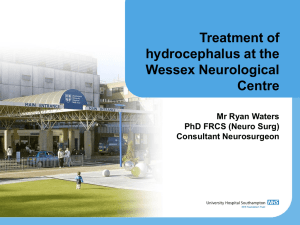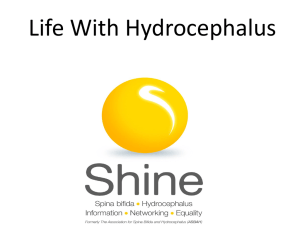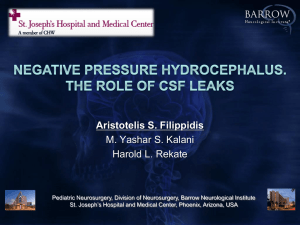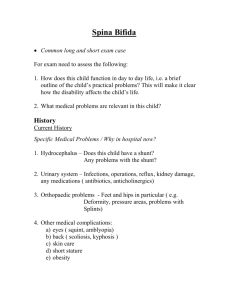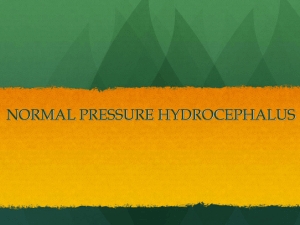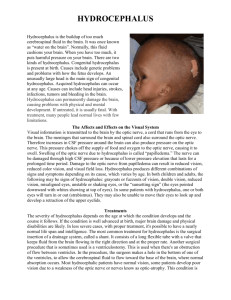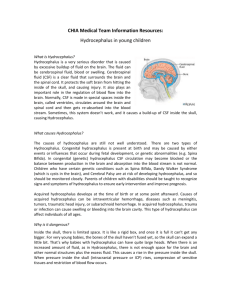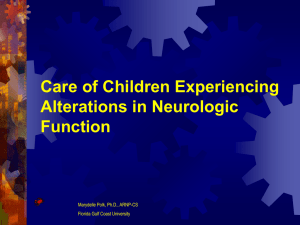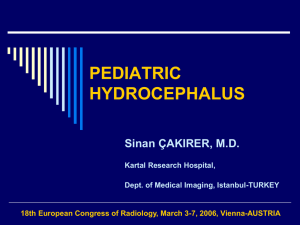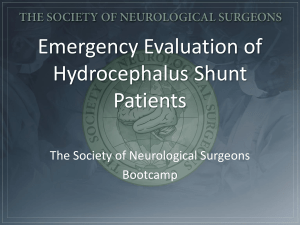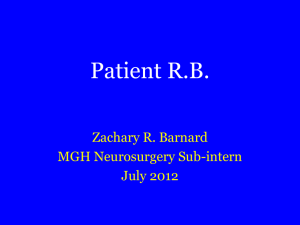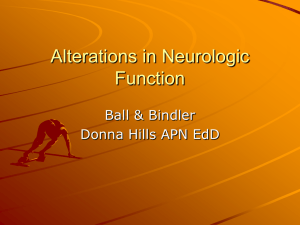POST INFECTIOUS HYDROCEPHALUS: The Most Common
advertisement
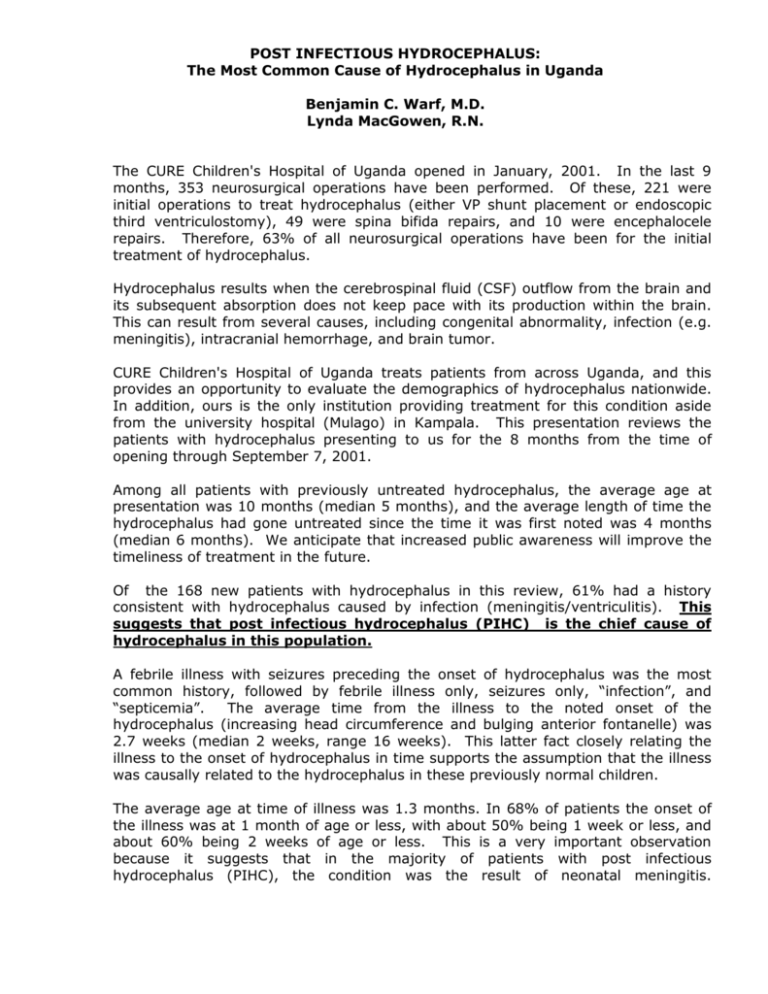
POST INFECTIOUS HYDROCEPHALUS: The Most Common Cause of Hydrocephalus in Uganda Benjamin C. Warf, M.D. Lynda MacGowen, R.N. The CURE Children's Hospital of Uganda opened in January, 2001. In the last 9 months, 353 neurosurgical operations have been performed. Of these, 221 were initial operations to treat hydrocephalus (either VP shunt placement or endoscopic third ventriculostomy), 49 were spina bifida repairs, and 10 were encephalocele repairs. Therefore, 63% of all neurosurgical operations have been for the initial treatment of hydrocephalus. Hydrocephalus results when the cerebrospinal fluid (CSF) outflow from the brain and its subsequent absorption does not keep pace with its production within the brain. This can result from several causes, including congenital abnormality, infection (e.g. meningitis), intracranial hemorrhage, and brain tumor. CURE Children's Hospital of Uganda treats patients from across Uganda, and this provides an opportunity to evaluate the demographics of hydrocephalus nationwide. In addition, ours is the only institution providing treatment for this condition aside from the university hospital (Mulago) in Kampala. This presentation reviews the patients with hydrocephalus presenting to us for the 8 months from the time of opening through September 7, 2001. Among all patients with previously untreated hydrocephalus, the average age at presentation was 10 months (median 5 months), and the average length of time the hydrocephalus had gone untreated since the time it was first noted was 4 months (median 6 months). We anticipate that increased public awareness will improve the timeliness of treatment in the future. Of the 168 new patients with hydrocephalus in this review, 61% had a history consistent with hydrocephalus caused by infection (meningitis/ventriculitis). This suggests that post infectious hydrocephalus (PIHC) is the chief cause of hydrocephalus in this population. A febrile illness with seizures preceding the onset of hydrocephalus was the most common history, followed by febrile illness only, seizures only, “infection”, and “septicemia”. The average time from the illness to the noted onset of the hydrocephalus (increasing head circumference and bulging anterior fontanelle) was 2.7 weeks (median 2 weeks, range 16 weeks). This latter fact closely relating the illness to the onset of hydrocephalus in time supports the assumption that the illness was causally related to the hydrocephalus in these previously normal children. The average age at time of illness was 1.3 months. In 68% of patients the onset of the illness was at 1 month of age or less, with about 50% being 1 week or less, and about 60% being 2 weeks of age or less. This is a very important observation because it suggests that in the majority of patients with post infectious hydrocephalus (PIHC), the condition was the result of neonatal meningitis. Therefore, it appears that neonatal meningitis may be the single major cause of hydrocephalus in Uganda. Although studies in Uganda have been insufficient, numerous previous studies elsewhere over several decades have demonstrated the most common organisms in neonatal meningitis to be E. coli and group B Streptococcus (60-90%). Neonatal meningitis is contributed to by the immature immune system of the newborn, maternal complications, and unclean environment. The mortality has been reported at anywhere from 15% to 75% (with higher mortalities reported in the older literature), and the incidence of subsequent hydrocephalus among survivors has been reported to be as high as 30%. The consideration of meningitis in other age groups is different. In this study, the onset of illness was between 1 and 3 months of age in 18%. The most common organisms in this age group include group B Streptococcus and Streptococcus pneumoniae. In the remainder of our patients (14%), the onset of illness was between 3 and 9 months. The most common pathogen of meningitis in this age group is Haemophilus influenza type B, which has been virtually eliminated in Europe and North America by the HiB vaccine. This immunization is not currently available in Uganda. Post infectious hydrocephalus (PIHC) may be caused by blockage of CSF flow at the aqueduct of Sylvius or the outlets of the IVth ventricle, blockage of flow within the subarachnoid spaces, or an impediment to CSF absorption. Neonatal meningitis has been previously reported to cause inflammation and destruction of the ependymal lining of the ventricles and inflammatory exudates and scarring which may obstruct the aqueduct, the outlets of the IVth ventricle, or the basal subarachnoid spaces around the IVth ventricle. Our findings in these patients (with PIHC) have included a small IVth ventricle in 44% on preoperative ultrasound imaging (which has correlated 100% with an obstructed aqueduct in patients undergoing ventriculoscopy). Intraventricular septations were also a common finding on ultrasound, indicative of prior ventriculitis. At endoscopy, the following findings were common among patients with PIHC: aqueduct obstructed by a web of tissue; yellow deposits on ependyma and choroid plexus; hemosiderin staining on ependyma, floor of 3rd ventricle, and around aqueduct; intraventricular webbing and anatomic distortion; scarring and atrophy of choroid plexus. All of this provides evidence of previous inflammation as the cause of the hydrocephalus in these patients, and that the hydrocephalus is often noncommunicating. Placement of a ventriculoperitoneal shunt (VPS) has been the standard treatment for PIHC. Endoscopic third ventriculostomy (ETV) is another alternative, but some modern authors have suggested PIHC as a contraindication to ETV. Our experience, however, suggests otherwise at this point. Among these 168 patients with hydrocephalus of all types, 163 shunts have been placed, and 64 endoscopic operations for attempted ETV have been performed during the period of review. Two types of shunts have been used: an American made Codman shunt and an Indian made Chhabra shunt. The cost of each shunt is about $650 USD and $35 USD, respectively. We were very interested in the relative performance of these shunts in general, and in PIHC in particular, because the economic ramifications are potentially important. We have thus far found no significant difference in performance between the two shunts, with the possible trend toward a slightly higher incidence of valve malfunction in the Chhabra shunt. CSF protein was significantly elevated in only a minority of PIHC patients at the time of shunt placement (13%), and valve malfunction and shunt obstruction incidence has not been higher among PIHC patients than among shunted patients with hydrocephalus of other etiologies thus far. Therefore, there is thus far no apparent advantage of the more expensive Codman shunt over the much less expensive Chhabra shunt, and shunting in children with PIHC has been as successful as for children with hydrocephalus from other causes. Post infectious hydrocephalus (with a prior history of meningitis) has been considered a contraindication to ETV by some authors. This is because of the concern that the principle etiology of the hydrocephalus is impairment of CSF absorption (i.e. communicating hydrocephalus). We began performing ETV at CURE Children's Hospital of Uganda 3 months ago. In our experience thus far, at 1 to 3 month’s follow up, ETV has been a successful treatment in 79% of the 32 patients with PIHC who have undergone ETV. The reasons contributing to this success may include the fact that the majority of PIHC in our patients arose from neonatal meningitis (which may have led to non-communicating hydrocephalus) and the fact that there was evidence of aqueduct obstruction in 70% of PIHC patients undergoing ETV. In conclusion: 1) Neonatal meningitis appears to be the single most common cause of hydrocephalus in Uganda. 2) This is a public heath/preventative medicine issue, which needs to be addressed. 3) ETV is a very effective treatment for post infectious hydrocephalus. 4) When a shunt must be used, inexpensive Chabra shunts perform well, and may be more cost effective.
